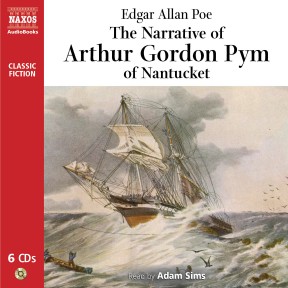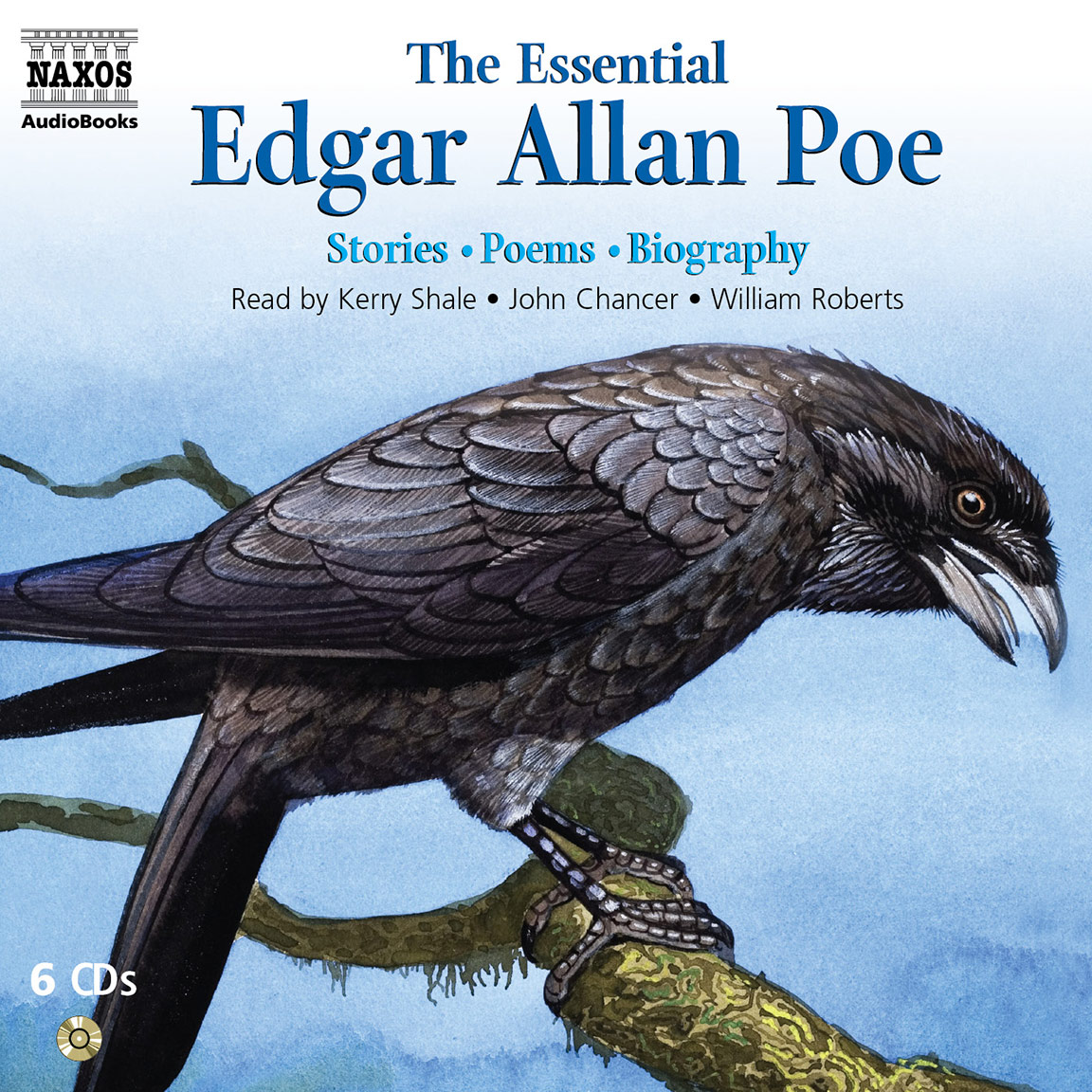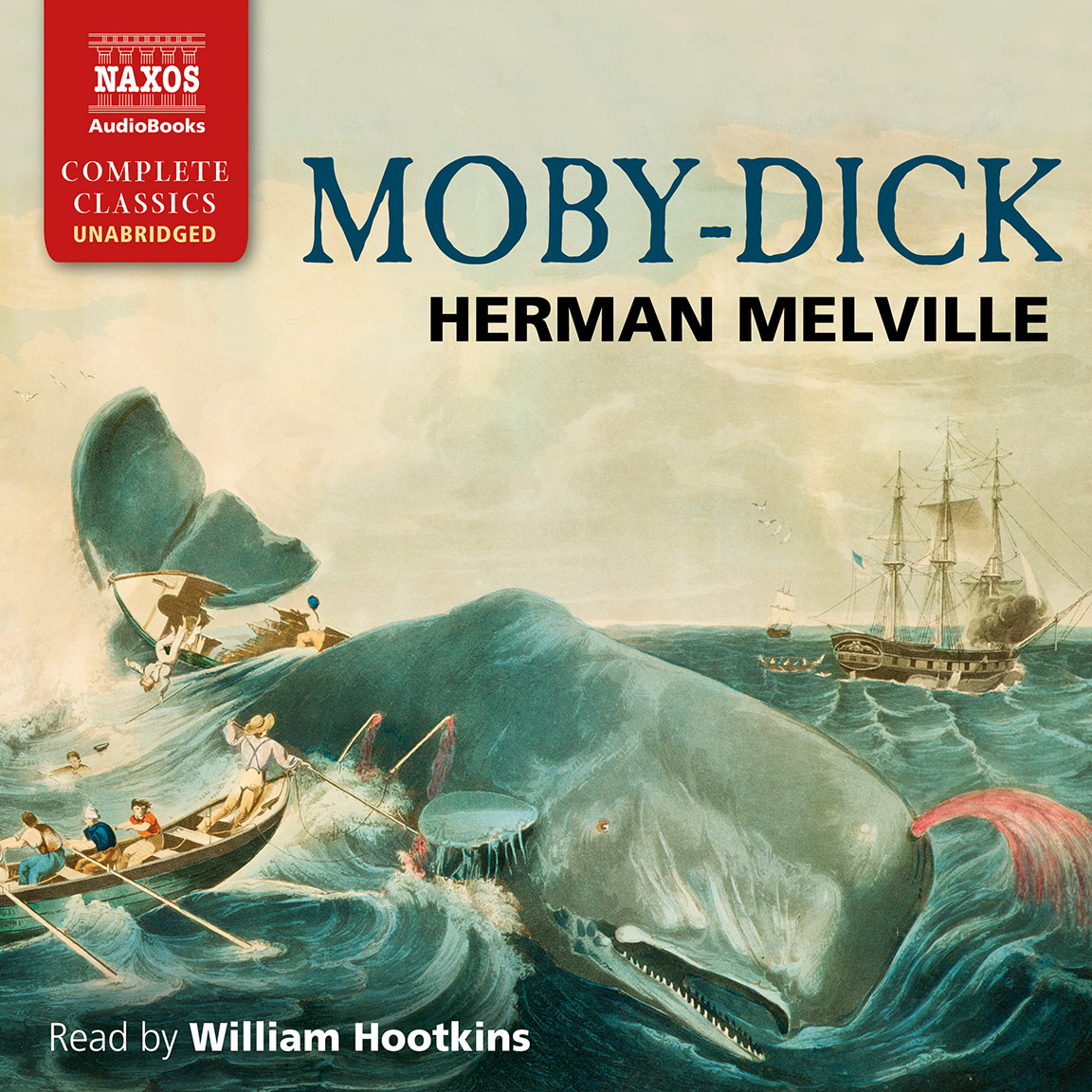
Audio Sample
Edgar Allan Poe
The Narrative of Arthur Gordon Pym
Read by Adam Sims
unabridged
The Narrative of Arthur Gordon Pym of Nantucket, Poe’s only full novel, is one of his most unusual works. A riveting story, in the first person, it tells of a disastrous sea voyage involving storms, mutiny, starvation, thirst and a mysterious conclusion. Jorge Luis Borges and Baudelaire were among those who rated it highly. The recording is timed to mark the 200th anniversary of Poe’s birth.
-
Running Time: 7 h 22 m
More product details
Digital ISBN: 978-1-84379-880-4 Cat. no.: NA695312 Download size: 108 MB BISAC: FIC004000 Released: March 2009 -
Listen to this title at Audible.com↗Listen to this title at the Naxos Spoken Word Library↗
Due to copyright, this title is not currently available in your region.
You May Also Enjoy
Reviews
Edgar Allan Poe’s The Narrative of Arthur Gordon Pym of Nantucket is adventure of a different sort – and the only full-length novel Poe ever wrote. Young Arthur stows away to go to sea with his friend Augustus, only to encounter mutiny, storms, cannibalism, a mysterious island in the Antarctic sea, ambush, and the loss of the ship. It’s a novel which influenced other writers such as Melville and Verne and one of the characters is named Richard Parker – the name which Yann Martell gave to the Bengal tiger in The Life of Pi – and though it’s a tad over-the-top, it’s hugely enjoyable nonetheless. Adam Sims is a terrific narrator.
Kati Nicholl, Daily Express
The crew of the whaler Grampus has mutinied with stowaway narrator Pym on board. The sufferings of the survivors are hideous, with starvation driving them to cannibalism. This is a teasing, gripping adventure that travels through the mysterious deep and the blackness of death to a strange world of ethereal whiteness.
Rachel Redford, The Observer
An unexpected turn of events transforms the novelty of life on the high seas into a nightmare. Going to sea with his best friend, the story’s first-person narrator, Arthur Pym, travels the world and miraculously survives abominable horrors—mutiny, shipwreck, abandonment at sea, and hostile natives in the Galapagos. Narrator Adam Sims has a youthful, slightly raspy voice that ideally suits the young narrator. His articulate enunciation and measured pace are consistent throughout the story. To accommodate Poe’s lengthy tangents, Sims shifts his tone to match the formality of the historical asides. Through his enthusiastic narration, Sims gives the listener an exciting rendering of Poe’s only novel.
T.D.M., AudioFile
In his late teens, Arthur Gordon Pym, hero of Edgar Allan Poe’s only full-length novel, runs away to sea with his friend, Augustus Bernard, on his father’s vessel, the American whaling brig, Grampus. Their plan is that Arthur will start the voyage as a stowaway, until they are far enough out to sea to prevent his return to Nantucket. Nothing goes according to plan, however. A couple of days out, a mutiny forces Augustus to conceal Arthur’s presence for his safety. Not only Arthur’s fate, but his very life is in question as conditions deteriorate, and the forces of man and nature rise against him. The tale is actually in two parts, the first records this voyage of the Grampus, the second deals with an ill-conceived and somewhat fantastical voyage to Antarctica. Poe’s sense of the macabre and unexpected pervades the novel, creating an ever-rising suspense. Adam Sims, a veteran of radio, television, and theater performances, renders a very successful recounting of Arthur’s tale, most of which is delivered in the first person. Sims conveys Arthur’s naivete, adventurous spirit, ingenuity, and optimism concerning all the perils that befall him during the two journeys. This audiobook will appeal to adult and teen readers alike who love sea stories with a captivating story line and laden with heightened suspense. Several graphic passages dealing with cannibalism and violence may not be appropriate for junior high audiences.
Susan Allison, Soundcommentary.com
Booklet Notes
Please note – elements of the plot are discussed in these notes.
Edgar Allan Poe was a journalist, editor, reviewer, poet and short-story writer, who became one of the most influential of all American authors. He opened up the newly independent country to the possibility of its own literature and created new genres of fiction, and after his death his work provided the primary source of some of the most inventive writing in the US or Europe, especially in the genres of the detective novel, science fiction and horror. The Narrative of Arthur Gordon Pym of Nantucket was his only novel. It begins as a dark, seafaring yarn; moves into a quasi-scientific exposition on the unknown worlds in the very southern seas; and then becomes something very different indeed, almost mystical in its ambivalence and strangeness.
Much of Poe’s reputation now rests on a handful of darkly imaginative short stories – The Pit and the Pendulum, The Murders in the Rue Morgue, The Tell-Tale Heart, The Masque of the Red Death – and the poem The Raven. The hallmarks of his style that were to be so influential can be seen in all of these: a brooding melancholy, a sense of the inevitability of early death, and a morbid relish in the terrors of incarceration. These dark elements inspired the French symbolists in their praise of Poe as a man who illuminated untouched areas of the human psyche. His use of science or exploration as a springboard for spinning a story appealed to Wells and Verne, while Arthur Conan Doyle was attracted by the capacity of the rational mind to untangle the apparently inexplicable, as well as a rather buccaneering sense of adventure. Arthur Gordon Pym includes many of these. But it also contains something much less clear, something that Herman Melville was to develop in Moby Dick: a voyage that is more than the purely physical, after a quarry that is perhaps intangible.
Arthur Gordon Pym is told in a straightforward, first-person narrative, with no dialogue, and recounts the adventures of the young Arthur as his fascination with the sea drives him to sneak away from home for a night-time sail with his friend Augustus. His yearning for the sailor’s life is undiminished by narrowly escaping death on this first foray onto the deep, and he again contrives to leave home and join Augustus on board a whaling ship, the Grampus, as a stowaway. But mutinous events on deck keep him in suffocating hiding until he is eventually discovered – and an even more hazardous expedition begins. The mutineers split into two camps; there is murder and callous butchery; and finally the few survivors are left helplessly at sea with no protection from the elements and little prospect of survival. After various gruesome ordeals have left just two people alive, they are rescued by a trading ship from Boston. The ship is heading south to hunt for seals and do business, but the captain is persuaded that there is also a chance to head into uncharted waters yet further south. In doing so, they encounter an initially friendly race of unknown peoples on the temperate island of Tsalal. However, these people, who are terrified of the colour white, are revealed as murderously traitorous. Pym and his friend escape, and head yet further south. Instead of becoming colder, the water and the weather warm up; a steady and increasing fall of something like white ash occurs; and they are heading towards what appears to be a huge waterfall when a figure in white steps out before them. The novel ends there, and the book is concluded with a note explaining the meaning behind some carvings and the shapes of caves found on the island of Tsalal.
The opening chapters were originally published in serial form early in 1837, and were claimed to be a genuine travelogue. But Poe lost his job at the magazine which published them and moved to New York where he completed the book. This accounts for the rather strained device of the preface where Pym – ostensibly the narrator – explains why certain portions of the book appeared earlier under Poe’s name. This conflating of fact and fiction was a typical trope of the author, and underlies much of the work. Poe took substantial chunks of the book from existing reports of trading in the southern oceans and used them to give credibility to his descriptions. But there is another, more autobiographical element to the story. For a start, the names Arthur Gordon Pym and Edgar Allan Poe are sufficiently similar to suggest the author is at least to be associated with the narrator. Then there is the mention of ‘Edgarton’, the suggestive shapes of the caves which Pym enters, and the fact that the natives of Tsalal cry ‘Tekeli-li!’ (as the Poe specialist at Penn State DuBois, Richard Kopley, notes, Poe’s mother, an actress, had appeared in a play called Tekeli). These elements added to the deeply uncertain nature of the book’s conclusion and have led to a wide and continuing diversity of opinion on how to interpret the work. Is it purely an adventure story or a journey of metaphorical discovery – either as a person or as an individual? Is it about race – the blackness of the treacherous Tsalal people contrasted with the whiteness towards which Pym sails? Or are the tales of Pym’s struggles an attempt to write an existential narrative about the constant threat of death? Poe’s own life offers material enough.
He was born in 1809 but was orphaned by the age of three and never fully adopted by his foster-father. Effectively cut off without a penny, and determined to make his living by his writing, he was frequently in penury. His sister was mentally ill, and his brother died of alcoholism; although Poe himself was not an alcoholic, drink was a serious problem for him. He could barely tolerate it, but went through periods when he drank regularly. As a result, he struggled to keep down a job, and one editor gave him a second chance only as long as he was at least sober before breakfast. He was almost constantly moving from place to place and magazine to magazine, while dreaming of owning and running a national literary journal. He was never, in truth, capable of such an enterprise.
There was not much relief in his romantic life, either. He was either attracted to women who were unattainable, or tubercular, or both. His early life was scarred by the deaths of his mother, his foster-mother and a mother figure in the form of a friend’s mother for whom he had developed a teenage crush. He married his cousin Virginia (whom he called ‘Sissy’) and lived with her and her rather dominant mother, Maria.
He died in 1849, having endured some years of profound mental strain, exacerbated by Virginia’s death two years previously. His death was as darkly mysterious as many of his tales. He died in Baltimore, but was supposed to have been travelling to New York; his whereabouts for three days beforehand are unknown; he was found almost insensible and wearing someone else’s clothes; and it has never been established what killed him – theories range from any number of illnesses to drugs, alcohol, mugging or rabies.
But this pained life was allied to a powerful imagination, a belief in the value of art, and a romantic morbidity that saw an inextricable link between beauty and death. Poe was also a gifted editor, an acerbic reviewer and talented journalist, with a capacity to write stories that tapped into the public’s imagination, leaving readers thrilled and intrigued. There is often much left unsaid in his fiction – his characters are rarely explained, their motives unclear, the reason for the frequent desolation never explored. But none of his other works quite prepares the reader for the shift in tone at the end of Arthur Gordon Pym. Whatever the reasons behind it, whatever inchoate imaginings lay beneath this extraordinary tale, Edgar Allan Poe created at once a typically gripping yarn and one of the most enigmatic stories of the sea.
Notes by Roy McMillan




